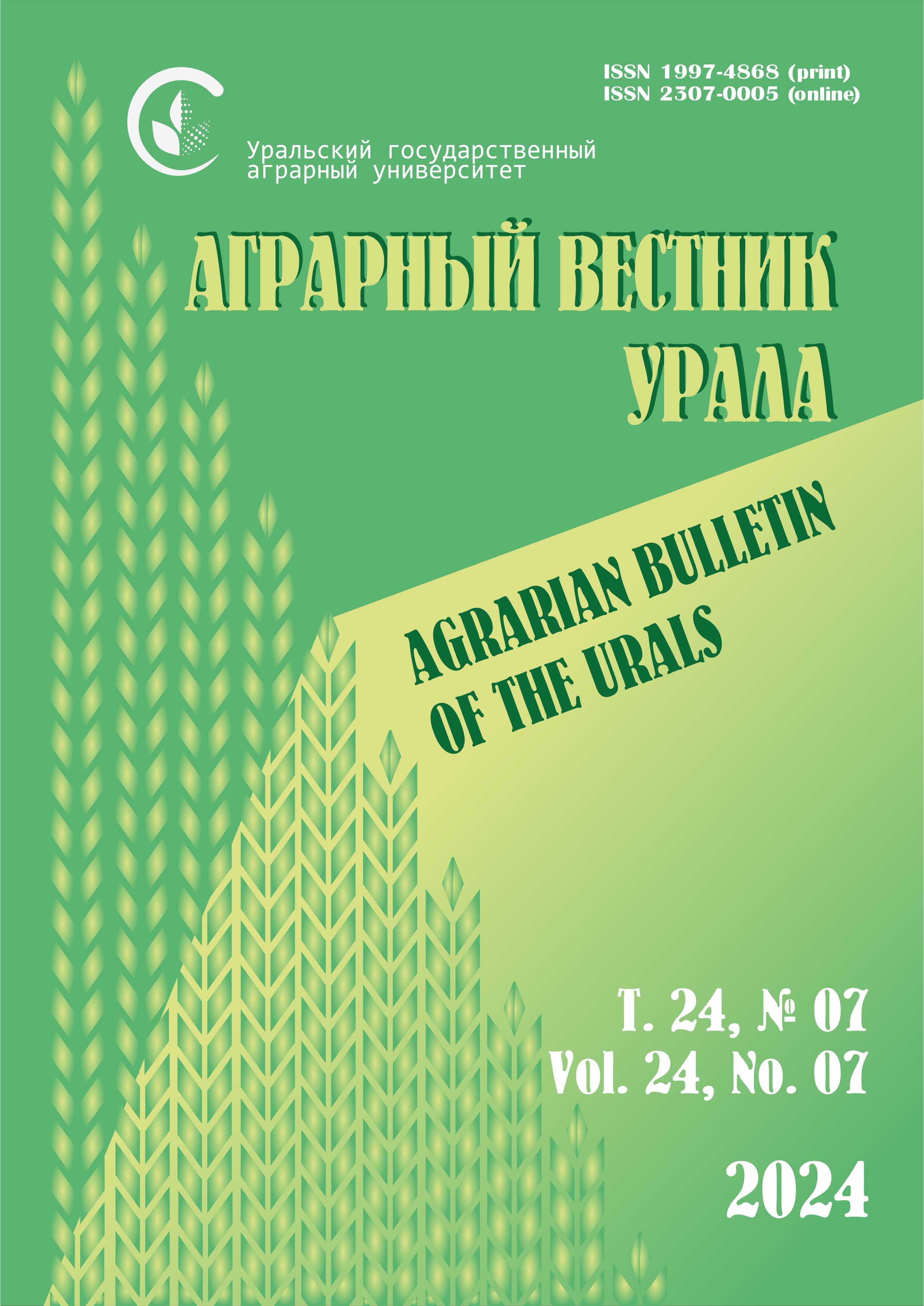Russian Federation
Russian Federation
Abstract. The economic efficiency of grain production is determined by the level of return on the resources spent by the cost of the products received. Weather factors play an important role. Climate changes in the Trans-Urals are primarily associated with the warming of the spring and summer months, increased aridity of the growing season and the expansion of the boundary of this process from the southeast to the northwest. The contrast in moisture availability of different years is combined with uneven precipitation in the region throughout the year. The profitability of farms in the production of grain crops is characterized by the same heterogeneity. The purpose of the study is to establish the economic efficiency of grain production in the context of climate change using the example of the Trans-Urals. The tasks are to analyze the impact of climate change on the yield of grain crops in the region, to analyze the efficiency of resource use by agricultural enterprises; using the example of the most highly profitable farms to identify factors to increase the efficiency of grain production. The methods of monographic and statistical analysis of data from scientific literature, open statistical sources, agronomic and economic reports of agricultural enterprises were used. The scientific novelty of the research consists in studying the efficiency of grain production in the context of climate change and in relation to the volatility of grain prices and means of production. The results of the study showed that since the early 2000s, despite a significant increase in the use of fertilizers, the growth of grain yields has stopped, which is primarily due to the deterioration of plant moisture conditions. At the same time, an increase in costs, although it leads to an increase in productivity, but to a lesser extent, as a result, the cost of grain increases, and the profitability of production decreases. Enterprises have been identified that, in the conditions of climate change and high volatility of grain prices and resources, have found ways to efficiently produce grain: replace solid fertilizers with liquid fertilizers, apply effective, including agrotechnical, methods of tillage and plant protection, use highly productive varieties, obtaining the highest profitability in the region.
climate, yield, grain production, economic efficiency, agricultural technologies, costs, profit, profitability
1. Popova K. Climate change and water availability in agriculture. IOP Conference Series: Earth and Environmental Science. 2019; Vol. 274. Article number 012117. DOI:https://doi.org/10.1088/1755-1315/274/1/012117. EDN: https://elibrary.ru/NEVYUB
2. Okolie C. C., Danso-Abbeam G., Groupson-Paul O., Ogundeji A. A. Climate-Smart Agriculture Amidst Climate Change to Enhance Agricultural Production: A Bibliometric Analysis. Land. 2023; Vol. 12, No. 1. Article number 50. DOI:https://doi.org/10.3390/land12010050. EDN: https://elibrary.ru/IWNICR
3. Toreti A., Bassu S., Asseng S., et al. Climate service driven adaptation may alleviate the impacts of climate change in agriculture. Communications Biology. 2022; Vol. 5, No. 1. Article number 1235. DOI:https://doi.org/10.1038/s42003-022-04189-9. EDN: https://elibrary.ru/QWFUWD
4. Golicyn G. S., Vasil'ev A. A. Izmenenie klimata i ego vliyanie na chastotu ekstremal'nyh gidrometeorologicheskih yavleniy // Meteorologiya i gidrologiya. 2019. № 11. S. 9–12. EDN: https://elibrary.ru/AQDTWK
5. Sineschekov V. E., Vasil'eva N. V., Dudkina E. A. Ekonomicheskaya effektivnost' proizvodstva zerna // Vestnik Kazanskogo gosudarstvennogo agrarnogo universiteta. 2018. T. 13, № 4 (51). S. 160–167. DOI:https://doi.org/10.12737/article_5c3de3a7e063f6.62004014. EDN: https://elibrary.ru/YWHCAX
6. Stepnyh N. V., Kopylova S. A., Nesterova E. V. Ekonomicheskaya effektivnost' ispol'zovaniya material'nyh resursov v rastenievodstve // Agrarnyy vestnik Urala. 2022. № 12 (227). S. 86–98. DOI:https://doi.org/10.32417/1997-4868-2022-227-12-86-98. EDN: https://elibrary.ru/WLJQYP
7. Urozhaynost' sel'skohozyaystvennyh kul'tur [Elektronnyy resurs]. URL: https://www.fedstat.ru/indicator/31533 (data obrascheniya: 11.09.2023).
8. Konovalova L. K., Okorkov V. V., Il'in L. I. Ekonomicheskaya ocenka agrotehnologiy pri razlichnyh sistemah udobreniya i urovnyah intensivnosti // Dostizheniya nauki i tehniki APK. 2018. T. 32. № 11. S. 85–90. EDN: https://elibrary.ru/YTALSP
9. Urozhaynost' sel'skohozyaystvennyh kul'tur (v raschete na ubrannuyu ploschad') [Elektronnyy resurs]. URL: https://www.fedstat.ru/indicator/30963 (data obrascheniya: 11.09.2023).
10. Ionova E. V., Lihovidova V. A., Lobunskaya I. A. Zasuha i gidrotermicheskiy koefficient uvlazhneniya kak odin iz kriteriev ocenki stepeni ee intensivnosti (obzor literatury) // Zernovoe hozyaystvo Rossii. 2019. № 6 (66). S. 18–22. DOI:https://doi.org/10.31367/2079-8725-2019-66-6-18-22. EDN: https://elibrary.ru/JLXVGY
11. Samygin D. Yu., Baryshnikov N. G., Mizyurkina L. A. Modeli scenarnogo prognozirovaniya razvitiya sel'skogo hozyaystva regiona // Ekonomika regiona. 2019. T. 15, № 3. S. 865–879. DOI:https://doi.org/10.17059/2019-3-18. EDN: https://elibrary.ru/RSVTNZ
12. Reestr selekcionnyh dostizheniy [Elektronnyy resurs]. URL: https://gossortrf.ru/registry (data obrascheniya: 11.09.2023).
13. Zaharov V. G., Yakovleva O. D. Rezul'tativnost' selekcii yarovoy myagkoy pshenicy na povyshenie urozhaynosti (na primere sortosmeny po Ul'yanovskoy oblasti) // Vestnik Ul'yanovskoy gosudarstvennoy sel'skohozyaystvennoy akademii. 2019. № 3 (47). S. 59–65. DOI:https://doi.org/10.18286/1816-4501-2019-3-59-65. EDN: https://elibrary.ru/ICIXFC
14. Neganova V. P., Dudnik A. V. Gotovnost' k innovaciyam v APK regiona kak sub'ektivnyy faktor innovacionnoy aktivnosti // Ekonomika regiona. 2019. T. 15, № 3. S. 880–892. DOI:https://doi.org/10.17059/2019-3-19. EDN: https://elibrary.ru/HBVKDA
15. Dudnik, A. V., Cherdakova T. A. Investicionnye strategii povysheniya konkurentosposobnosti agroprodovol'stvennoy sistemy strany // Ekonomika regiona. 2021. T. 17, № 2. S. 632–643. DOI:https://doi.org/10.17059/ekon.reg.2021-2-20. EDN: https://elibrary.ru/GTCXNL









